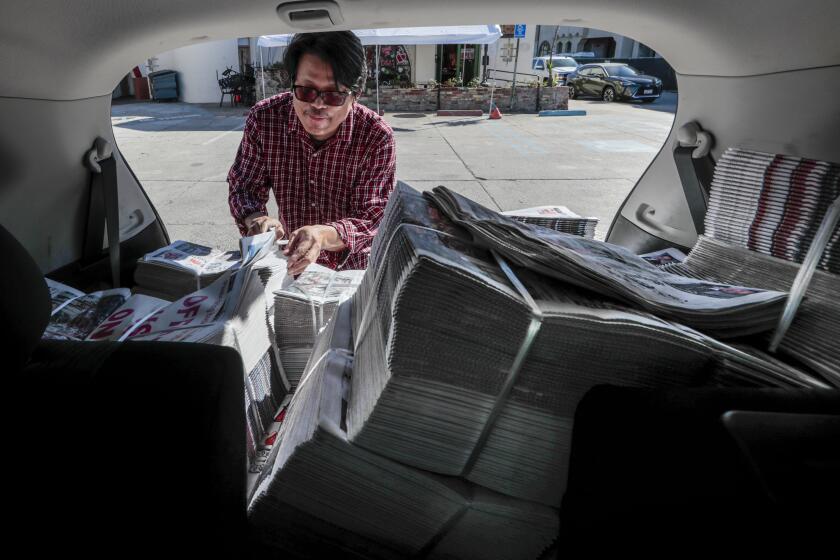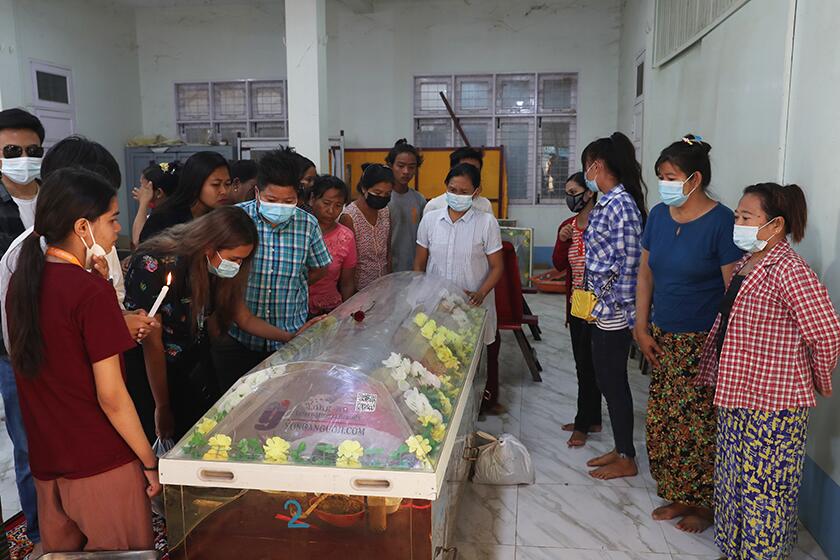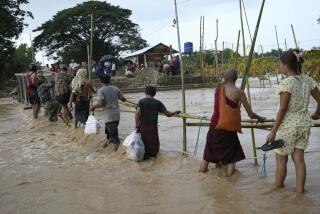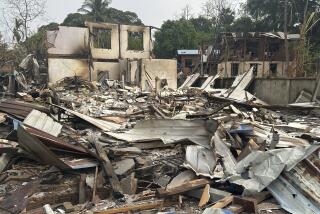Deadly violence follows peaceful protests in Myanmar
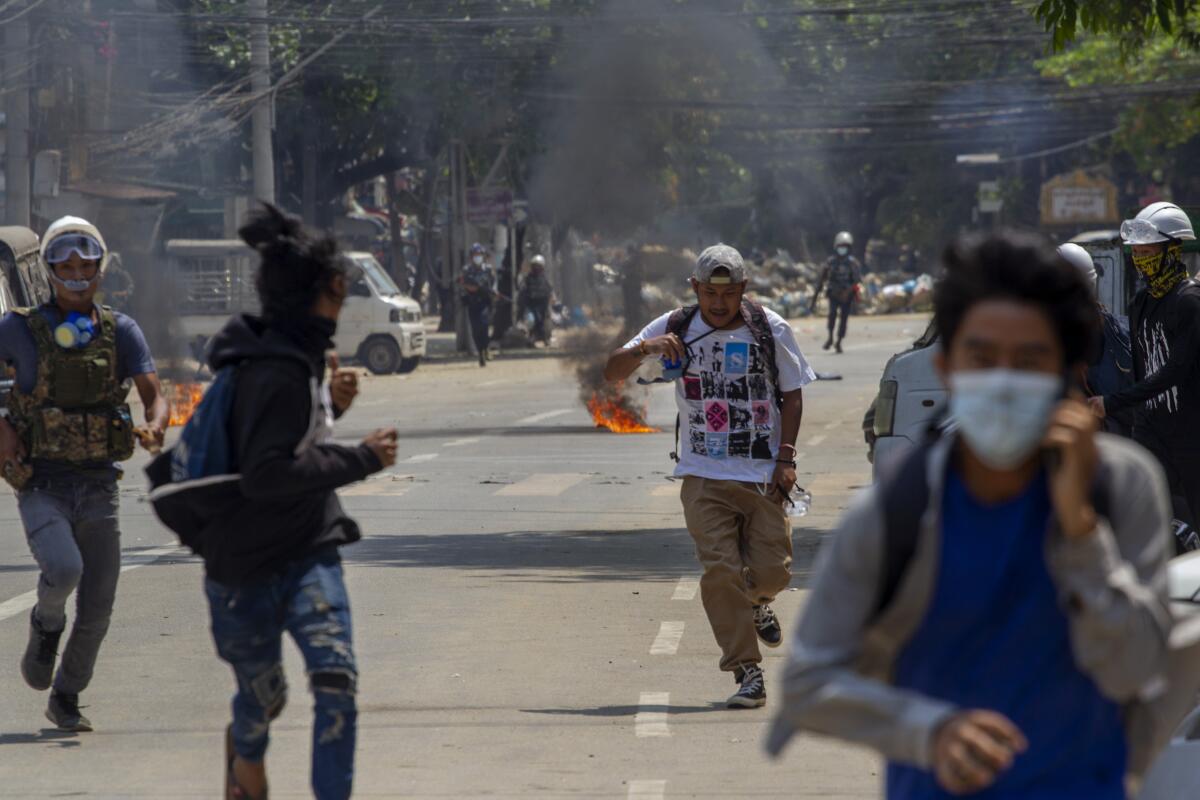
- Share via
YANGON, Myanmar — At least two people protesting last month’s military coup were reported shot and killed by security forces Tuesday after a morning of peaceful marches in parts of Myanmar.
Security forces have killed scores of their countrymen in recent days, and the United Nations has put the nationwide death toll at 149 since the Feb. 1 coup that toppled Aung San Suu Kyi’s elected government.
The independent Assistance Assn. for Political Prisoners said 183 people have been killed since the coup.
Violence was reported Tuesday in the biggest city, Yangon, where casualties have been the highest. Police fired rubber bullets in several neighborhoods, and one man was reported killed. Another killing was reported in Kawlin city in the northwestern region of Sagaing.
U.N. Human Rights Office spokeswoman Ravina Shamdasani said at least 11 people were killed Monday, adding to 57 deaths over the weekend. Although there were many more reports of killings, it was unable to corroborate them.
“The killing of demonstrators, arbitrary arrests and the reported torture of prisoners violate fundamental human rights and stand in clear defiance of calls by the Security Council for restraint, dialogue and a return to Myanmar’s democratic path,” said U.N. Secretary-General António Guterres.
The coup reversed years of slow progress toward democracy in Myanmar, which for five decades had languished under strict military rule that led to international isolation and sanctions.
Thakhin Kai Bwor is the editor of the Myanmar Gazette, the only Burmese-language newspaper in the U.S. For many readers, it’s also a how-to guide for life in America.
Protesters in some areas have recently used tactics meant to avert violent confrontations. On Tuesday, social media reports said candlelight marches before sunrise were held in Mawlamyine in Mon state in southeastern Myanmar.
Another tactic has been to use signboards as proxies for human protesters, placing them in rows in public places. This tactic was reported to have been used by a group of engineers in the second-biggest city, Mandalay, in central Myanmar.
More conventional peaceful protests of the sort that have been occurring daily were held without incident Tuesday in Monywa and Ye-U in central Myanmar, the city of Loikaw in the eastern state of Kayah, and Kalaw in Shan state, also in the east.
Complicating efforts to organize new protests as well as media coverage, cellphone internet service was cut Sunday night, although access was still available through fixed broadband connections.
Mobile data service had been used to stream live video coverage of protests, often showing security forces attacking demonstrators. It previously had been turned off from 1 a.m. to 9 a.m. for several weeks, with no official explanation.
Sunday’s violence in Yangon — virtually all by police — led to the greatest single-day death toll since the coup. Myanmar’s ruling junta declared martial law in a large part of the city.
Kyal Sin wore a T-shirt that said ‘Everything will be OK’ when she was shot by Myanmar security forces on the deadliest day since the military coup.
The martial law announcements said that the junta, formally called the State Administrative Council, acted to enhance security and restore law and order, and that the Yangon regional commander has been entrusted with administrative, judicial and military powers in the area under his oversight. The orders cover six of Yangon’s 33 townships.
The greatest violence and most deaths were reported in Yangon’s Hlaing Thar Yar township, an industrial area of many factories that supply the garment industry, a major source of income for Myanmar. Several factories, many of which are Chinese-owned, were set ablaze Sunday by unknown parties, provoking the ire of Beijing.
Thousands of the township’s residents in cars, taxis and pickup trucks, as well as on motorcycles and on foot, jammed roads out of the area Tuesday. Some sought safety; others no longer have jobs.
Protesters in the last week have responded to increased police violence by taking a more aggressive approach to self-defense, burning tires at barricades and pushing back when they can against attacks.
The Committee Representing Pyihtaungsu Hluttaw, comprising elected members of parliament who were not allowed to take their seats, said Sunday that the general public has the legal right to self-defense against security forces.
The committee, which operates underground inside the country and with representatives abroad, has established itself as a shadow government that claims to be the sole legitimate representative body of Myanmar’s citizens. It has been declared an illegal treasonous organization by the junta.
State television MRTV announced Tuesday evening that a leading figure on the committee, known as Dr. Sasa, was charged with high treason, which carries a death sentence.
Sasa, a medical doctor who uses a single name, is a member of the Chin ethnic minority and was appointed a special U.N. envoy by the committee, is accused of stirring up internal conflict and acting against the junta, which claims to be the sole legitimate ruling body despite having ousted an elected government.
The doctor is the public face of the Myanmar resistance in the international arena, even though he reportedly is in hiding. He has spoken frequently with the international press by videoconference. He also has been in touch via video with foreign diplomats, U.N. officials and other junta opponents, including members of ethnic minorities who maintain their own guerrilla armies.
The state-owned Global New Light of Myanmar newspaper reported that junta chief Senior Gen. Min Aung Hlaing told colleagues the protests have turned into “riots and violence.”
Speaking at a Monday meeting of the junta in the capital, Naypyidaw, Min Aung Hlaing was quoted as saying the military was aiding police “as rearguards in required places to solve the difficulties and obstacles.”
“Although there have been fewer protests, violent acts emerged in some areas, such as burning public property and factories. So, security forces” had to crack down, according to the account. “The protesters raided police stations and administrative offices and burned factories. Meanwhile, the shooting [was] to disperse the protesters, resulting in some security forces and protester casualties.”
Virtually all independent accounts blame security forces for initiating violence against unarmed protesters.
Many protesters have called for foreign intervention to aid them under the doctrine of Responsibility to Protect, or R2P, devised to deal with matters such as genocide, war crimes, ethnic cleansing and crimes against humanity.
The U.N. and other regional bodies and nations have urged measures to reconcile the protesters and military and bring an end to violence. Several Western nations imposed sanctions against the generals and their business connections, but the junta is confident it can withstand the pressure, especially with China as a diplomatic ally who can block coordinated U.N. action and make up shortfalls in aid and investment.
U.S. Secretary of State Antony J. Blinken, in Tokyo for talks with Japanese officials, explained that Washington wants to promote democratic principles in Myanmar, as it does elsewhere.
“We believe in democracy and human rights, the rule of law, because we’ve seen how our own countries are stronger, because we adhere to those values, and because they are under threat in may places, including in this region,” he said. “In Burma, the military is attempting to overturn the results of a democratic election and is brutally repressing peaceful protests.” The United States calls Myanmar by its old name, Burma, which was changed by a previous military government.
Japanese Foreign Minister Toshimitsu Motegi said after his meeting with Blinken that they shared “strong concern” over the situation in Myanmar, especially attacks on peaceful demonstrations.
“There have been casualties among civilians, and we are strongly concerned about the development,” he said, adding that they demand Myanmar immediately release Suu Kyi and restore a democratic system.
More to Read
Sign up for Essential California
The most important California stories and recommendations in your inbox every morning.
You may occasionally receive promotional content from the Los Angeles Times.
